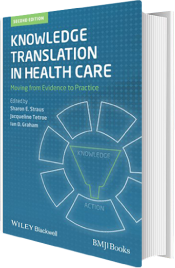Sharon E. Straus, MD, MSc, FRCPC
Eman Leung, PhD
Download: Presentation (PDF, 190KB)
The K in KT: Knowledge Creation
- At the center of the Knowledge-To-Action Cycle is the “Knowledge Funnel”
- This represents the process through which knowledge is refined, distilled, and tailored to the needs of knowledge end-users such as health care professionals and policy makers
The “Knowledge Funnel”
1. Knowledge Inquiry
- Describes the act of deriving knowledge from the multitude of primary studies such as randomized trials
- The product of studies such as these is referred to as ‘first generation knowledge’
- This knowledge in its natural state is largely unrefined
-
Example
- Primary research studies reported inconsistent effect of antibiotics on URTI such as sore throat
- Use of antibiotics associated with development of resistant organisms
2. Knowledge Synthesis
- ‘second-generation knowledge’- it represents the aggregation of existing knowledge
- The process of aggregation involves application of explicit and reproducible methods to identify, appraise, and synthesize studies relevant to a specific question in order to minimize bias and random error
- Examples of knowledge syntheses include systematic reviews, meta-syntheses, scoping reviews, and realist reviews
-
Example
- When the day-3 and week-1 effects of antibiotics on sore throat were aggregated across all primary studies with respect to their sample size, the meta-analysis revealed only modest effects;
-
The number of patients that needed to be treated for the treatment to be considered beneficial in preventing one sore throat was 6 and 21 for day 3 and week 1 respectively
(Arnold & Straus, 2005; Cochrane Database of Systematic Reviews)
3. Knowledge Tools/Products
- Synthesized knowledge is used to create knowledge tools and products
- Two examples of knowledge translation tools include: clinical practice guidelines and patient decision aids
-
Clinical practice guidelines:
- help clinicians and patients make decisions about appropriate health care for specific clinical circumstances
- inform decisions make by health care policymakers and clinical managers
-
Patient decision aids
- help clarify the value patients place on benefits versus harm
- guide the process of decision making
- translate best available evidence into patient-friendly tools to inform patients about their options
-
Example
-
The Centres for Disease Control and Prevention in the United States developed a guideline stating that antibiotics should not be prescribed for acute uncomplicated respiratory track infection in otherwise healthy adult patient
(see Cooper et al, 2001; Snow et al, 2001a,b)
-
The Centres for Disease Control and Prevention in the United States developed a guideline stating that antibiotics should not be prescribed for acute uncomplicated respiratory track infection in otherwise healthy adult patient

